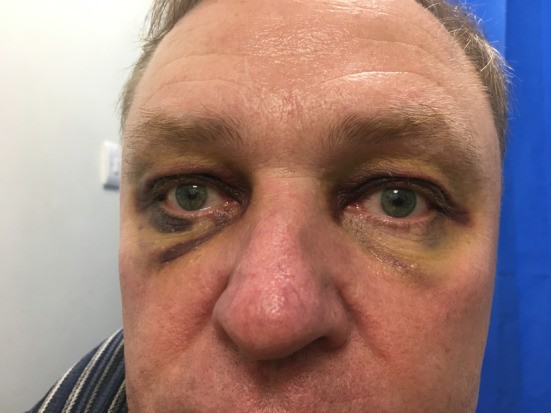Panda eyes, medically known as periorbital ecchymosis, refer to bruising around the eyes, resembling the markings of a panda. While often associated with a basal skull fracture, they can also arise from other causes. This article delves into the causes, diagnosis, and management of panda eyes, providing a comprehensive overview of this clinical sign.
Causes of Panda Eyes
Periorbital ecchymosis occurs when blood vessels beneath the skin around the eyes rupture, leading to blood pooling in the surrounding tissues. This results in the characteristic bruising and discoloration.
The most common cause of panda eyes is a basal skull fracture. A basal skull fracture is a break in one or more of the bones at the base of the skull. These fractures can damage blood vessels in the skull, causing blood to leak into the soft tissues around the eyes.
However, panda eyes aren’t always indicative of a serious injury like a skull fracture. Other potential causes include:
- Facial Trauma: Direct trauma to the face, such as a blow to the nose or forehead, can cause blood vessels to rupture and result in periorbital ecchymosis.
- Cosmetic Surgery: Procedures like rhinoplasty (nose job) or blepharoplasty (eyelid surgery) can sometimes lead to temporary bruising around the eyes.
- Allergic Reactions: Severe allergic reactions can cause swelling and inflammation around the eyes, which may be accompanied by bruising.
- Certain Medical Conditions: In rare cases, panda eyes can be a symptom of certain medical conditions, such as amyloidosis or blood clotting disorders.
Diagnosing the Cause of Panda Eyes
When someone presents with panda eyes, it’s crucial to determine the underlying cause. A thorough medical evaluation is necessary to rule out any serious injuries or medical conditions.
The diagnostic process typically involves:
- Physical Examination: The doctor will examine the patient for other signs of trauma, such as Battle’s sign (bruising behind the ear), rhinorrhea (CSF leaking from the nose), or otorrhea (CSF leaking from the ear).
- Neurological Examination: A neurological exam is performed to assess the patient’s mental status, reflexes, and motor function.
- Imaging Studies: Computed tomography (CT) scans of the head are often used to visualize the skull and brain, helping to identify any fractures or intracranial injuries.
Treatment and Management
The treatment for panda eyes depends on the underlying cause.
- Basal Skull Fracture: Most closed, non-depressed skull fractures without intracranial pathology, neurological deficits, or CSF leak are treated conservatively. Surgical intervention may be required for associated intracranial hemorrhage, persistent CSF leakage, or significant wound contamination. The surgical procedure involves debridement of devitalized tissues, evacuation of intracranial lesions, dural closure, and cranioplasty.
- Facial Trauma: Minor bruising from facial trauma typically resolves on its own within a few weeks. Applying ice packs to the affected area can help reduce swelling and pain.
- Cosmetic Surgery: Bruising after cosmetic surgery is usually temporary and can be managed with cold compresses and pain medication.
- Allergic Reactions: Antihistamines or other medications may be prescribed to treat the allergic reaction and reduce swelling.
- Medical Conditions: Treatment for panda eyes caused by medical conditions will focus on addressing the underlying condition.
When to Seek Medical Attention
It’s essential to seek immediate medical attention if you develop panda eyes, especially if:
- They occur after a head injury.
- You experience other symptoms, such as headache, dizziness, vision changes, or loss of consciousness.
- There are signs of CSF leakage from the nose or ears.
Conclusion
Panda eyes, or periorbital ecchymosis, can be a sign of a serious underlying condition, such as a basal skull fracture. While they can also result from less severe causes like facial trauma or cosmetic surgery, it’s crucial to seek medical attention to determine the underlying cause and receive appropriate treatment. Early diagnosis and management can help prevent complications and ensure a favorable outcome.

